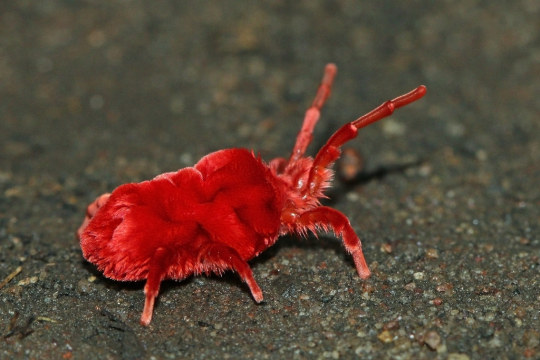#Dinothrombium
Explore tagged Tumblr posts
Text



The first giant red velvet mites of the season.
They don't look very fearsome, but these little fluffballs are predators. They live underground, and the adults only emerge after heavy rain to hunt for swarming termites. You can read more about them at BugGuide.
Cochise County, Arizona, July 4, 2024.
#mite#red#red velvet mite#cute#photographers on tumblr#textless#amadee ricketts#arizona#macro#fuzzy#fluffy#texture#summer#monsoon#grass#dirt#hole#giant red velvet mite#Dinothrombium
122 notes
·
View notes
Text
À la rencontre d'un arthropode qui a le goût (amer) de la quinine et du piment habanero !
See on Scoop.it - EntomoNews
Known as the "King of Sting," Justin Schmidt has dedicated his life to the study of insects, mostly the stinging kind. In a recent paper, he explores giant velvet mites – elusive creatures of the arachnid family. Among his discoveries: Virtually no one wants to eat them, suggesting the mites have to contend with few, if any, predators.
Meet the bug that tastes 'like quinine with habanero'
By Daniel Stolte, University Communications
Jan. 23, 2023
[Image] A giant velvet mite with its favorite prey, a winged termite. Jillian Cowles
-------
NDÉ
Traduction
Surnommé le "roi de la piqûre", Justin Schmidt a consacré sa vie à l'étude des insectes, surtout ceux qui piquent. Dans un récent article, il a publié l'aboutissement de plus de 30 ans de recherche sur les acariens géants du velours - des créatures insaisissables de la famille des arachnides.
Parmi ses découvertes : Pratiquement personne ne veut les manger, ce qui suggère que les acariens doivent faire face à peu de prédateurs, voire aucun.
Qu'est-ce qui est velouté, rouge, de la taille d'un pois et que l'on peut voir courir sur le sol dans le désert du Sud-Ouest après une pluie torrentielle ? Si vous n'en avez aucune idée, vous n'êtes pas seul. Selon Justin Schmidt, chercheur adjoint au département d'entomologie de l'université d'Arizona, les acariens géants du velours sont des créatures si insaisissables qu'on en sait peu sur elles.
M. Schmidt, que l'on a surnommé "le roi de la piqûre" en raison de ses exploits à travers le monde à la recherche d'insectes piqueurs, s'intéresse à ces acariens dans un article récemment publié qu'il a cosigné avec sa femme, Li Schmidt. Il qualifie cet article, publié dans le Journal of Arachnology, de "point culminant de plus de 30 ans de recherche sur les acariens géants de velours".
University of Arizona News s'est entretenu avec Schmidt au sujet des découvertes surprenantes qu'il a faites en observant ces minuscules arachnides, en les opposant à des prédateurs et... en les goûtant.
L'étude
Big, bad, and red: Giant velvet mite defenses and life strategies (Trombidiformes: Trombidiidae: Dinothrombium) - The Journal of Arachnology, 10.08.2022 https://bioone.org/journals/the-journal-of-arachnology/volume-50/issue-2/JoA-S-21-019/Big-bad-and-red--Giant-velvet-mite-defenses-and/10.1636/JoA-S-21-019.full
0 notes
Photo

Giant red velvet mite (Dinothrombium sp.) in Ghana
Charles Sharp
571 notes
·
View notes
Photo

been a while but ITS TIME FOR ADOPTS!! made these designs based on some very cool arthropods and i hope they get good homes :] all payment is in usd through paypal! more info+transcription of image text under the cut
Red Carpet Rainbug (Dinothrombium): $50
Weevil Wizard (Pachyrhynchus argus): $60
Bass Beetle (Phanaeus vindex): $50
SOLD! Masked Moth (Idalus herois): $50
#adopts#adoptables#insects#arthropods#anthro#character design#what do you tag this as help#bugs#clowns#idk#don does art
12 notes
·
View notes
Photo

Giant Red Velvet Mite (Dinothrombium sp) by Charles Sharp
1K notes
·
View notes
Photo



Arachnids on the prowl! During spring as the ground water percolates up and dormancy starts to break, the forest floors’ microbiota starts letting the food foundation become a solidified part of the ecosystem once more. With this upwelling and microbiome alive and well many arthropods become more active. As the soil becomes more saturated with snow melt and spring rains and nutrient cycles churn we can see these little fuzzy dudes appearing.
This is a giant red velvet mite or red rain bug, Dinothrombium sp., which is most likely searching for eggs or termites. It gets it’s second name from it appearing after heavy rainfalls the first common name is just based on appearance. This species isn’t terrifically known to be found commonly in Ohio; however, I live in southern Ohio so it’s not surprising to find one.
#arachnids#class#archnida#mites and ticks#order#acari#ohio#midwest#family of chiggers and small ticks#thrombidiidae
0 notes
Photo





The first peppermint mite* of monsoon season. Coronado National Memorial, Cochise County Arizona, July 4, 2021.
* It’s really just a red velvet mite with different coloration, but these look like Starlight Peppermints to me, and I always think of them that way.
#red velvet mite#arizona#monsoon#red#photographers on tumblr#textless#amadee ricketts#peppermint mite#texture#fuzzy#cute#mite#look at that fuzzy tummy!#giant red velvet mite#Dinothrombium
2K notes
·
View notes
Photo









Red velvet mites after one of the first big monsoon storms. Coronado National Memorial, July 4, 2021.
#mite#red velvet mite#arizona#red#photographers on tumblr#textless#amadee ricketts#sand#grass#texture#fuzzy#these little guys are my favorite#and i am mystified that they can stay so clean#since they come out of holes in the ground#after torrential rains#Dinothrombium
163 notes
·
View notes
Photo

#mite#red velvet mite#red#arizona#photographers on tumblr#textless#amadee ricketts#macro#grass#running#texture#fuzzy#the mites with pale markings look like starlight mints to me#so i think of them as peppermint mites#giant red velvet mite#Dinothrombium
2K notes
·
View notes
Photo

#mite#red velvet mite#fuzzy#face#photographers on tumblr#textless#amadee ricketts#sand#macro#arizona#red#of course this was in july#Dinothrombium#giant red velvet mite
711 notes
·
View notes
Photo

#red velvet mite#sand#red#arizona#photographers on tumblr#textless#amadee ricketts#twig#fuzzy#macro#of course this was in july#giant red velvet mite#Dinothrombium
98 notes
·
View notes
Photo

#mite#red velvet mite#arizona#dirt#photographers on tumblr#textless#amadee ricketts#running#macro#peppermint mite#of course this was in july#giant red velvet mite#Dinothrombium
124 notes
·
View notes
Photo

#mite#red velvet mite#macro#arizona#photographers on tumblr#textless#amadee ricketts#red#fuzzy#sand#rock#of course this was in july#giant red velvet mite#Dinothrombium
116 notes
·
View notes
Photo










#mite#red velvet mite#red#arizona#photographers on tumblr#textless#amadee ricketts#dirt#grass#dry#fingers#macro#the mites with pale markings look like starlight mints to me#so i think of them as peppermint mites#Dinothrombium#giant red velvet mite
172 notes
·
View notes

